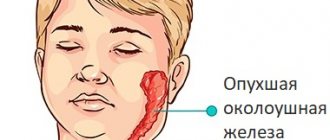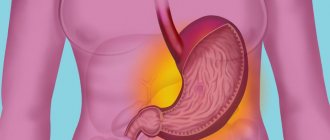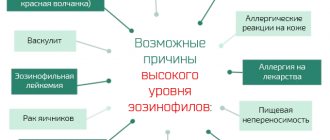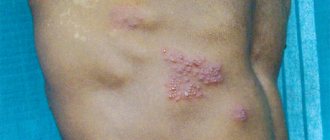Mechanism of development of asthenia
Asthenic syndrome is a psychopathological disorder that develops against the background of other diseases that lead to depletion of the human body. Some doctors and scientists consider asthenic syndrome to be a precursor to various serious diseases of the nervous system.
By the way, many people understand asthenia to be ordinary fatigue, but this is a mistaken opinion. Ordinary fatigue is a physiological condition that develops in a person as a result of the influence of physical and psychological stress on the body, usually very intense. Fatigue is short-term, so it will go away with normal rest. But asthenia is its pathological form. When this disease appears, the body does not have any intense excessive stress, but the fatigue itself is chronic.
This condition cannot appear in just one day. The diagnosis is made if the signs of an asthenic condition do not go away for a long time. Gradually, the clinical picture becomes more pronounced, and the patient’s quality of life worsens. As a result, only one rest (even a long, full one) is not enough to restore the strength of the human body. Complex therapy is required, which is prescribed by a neurologist.
Asthenia is understood as the human body’s reaction to a condition that threatens complete depletion of all energy resources. With this pathology, the activity of reticular-type formations primarily changes. These are structures that are located in the brain stem. They are responsible for the perception of the world, attention, motivation, wakefulness and sleep, regulation of autonomic systems, functioning of the muscular system and all activity of the human body as a whole. The adrenoline pituitary-hypothalamic system, which plays an important role in the occurrence of stress, changes.
Immunological mechanisms are also of great importance in the appearance of asthenia. According to studies, various disturbances in the functioning of the immune system were found in people who suffered from this pathology. However, there are currently no viruses known that could directly influence the appearance of asthenic syndrome.
Diagnosis of asthenic manifestations
Due to the fact that asthenic syndrome causes multiple symptoms characteristic of various mental disorders, this nervous pathology is difficult to diagnose.
To accurately determine the disease, the patient is tested, during which it is necessary to answer more than 10 questions. The survey results show the presence or absence of symptoms characteristic of asthenia.
Psychopathological disorder must be differentiated from other similar disorders:
- hypochondriacal neurosis;
- hypersomnia;
- depressive neurosis.
In this case, additional research helps to identify the cause. Asthenic syndrome is diagnosed by performing a number of laboratory tests:
- clinical and biochemical blood test;
- PCR diagnostics;
- bacteriological blood test;
- general urine analysis;
- coagulogram;
- coprogram.
If damage to the central nervous system or VSD is suspected, an MRI of the brain is prescribed. Additional examinations are also carried out to identify disturbances in the functioning of other organs.
Causes of pathology
The causes of asthenia are very different. This condition develops under the influence of a number of factors that deplete the mechanism for the formation and use of energy in the human body. The basis for the development of asthenic syndrome is severe overstrain, depletion of various mechanisms and structures that are responsible for nervous activity. At the same time, vitamin deficiency and lack of microelements and nutrients affect it. As a result, the metabolic process is disrupted.
Typically, this condition develops against the background of the following diseases:
- Infectious. For example, this could be hepatitis, tuberculosis, ARVI, influenza, brucellosis, toxic infections in the digestive organs, etc.).
- Diseases of the gastrointestinal tract. For example, most often chronic fatigue appears against the background of pancreatitis, colitis, enteritis, gastritis (in acute and chronic form), peptic ulcer, and dyspepsia.
- Diseases of blood vessels and heart. This takes into account arrhythmia, atherosclerosis, hypertension, ischemia, and myocardial infarction.
- Respiratory diseases: pneumonia, chronic obstructive pulmonary disease, bronchial asthma.
- Kidney diseases. For example, glomerulonephritis and pyelonephritis in chronic form.
- Pathologies of the endocrine system. For example, this is hyper- and hypothyroidism, diabetes mellitus.
- Blood diseases, especially anemia.
- Diseases of the nervous system (multiple sclerosis, encephalitis, neurocirculatory dystonia, etc.).
- Neoplastic processes. This includes various tumors, especially those that are malignant.
- Mental illnesses: schizophrenia and depression.
- Injuries. This is especially true for cranial problems.
- Postpartum recovery period.
- Pregnancy (especially if there are several fetuses) and lactation period.
- Postoperative recovery period.
- Psycho-emotional stress.
- Use of certain medications. This usually applies to psychotropic drugs.
- Drug use.
- For children, individual factors may include an unfavorable family environment, difficulties with the team at school or kindergarten, and excessive demands from parents and teachers.
In addition, monotonous tasks play a big role, especially if you have to work in poor lighting and in a confined space. Working at night has a negative impact. In addition, it will be difficult for people who are required to process a very large amount of data in a short time. Sometimes even moving to a new place of work can also lead to pathological fatigue.
Signs of asthenia
This pathological condition in people, depending on age, gender, social status and a number of other factors, can have many manifestations. The most characteristic signs of this disorder include:
- general weakness;
- fast fatiguability;
- increased irritability;
- sexual disorders;
- deterioration of health;
- dissatisfaction with other people;
- headache;
- poor tolerance to bright light and loud sounds;
- loss of appetite;
- worry for no reason, etc.
Vegetative symptoms may appear. Patients often complain of increased heart rate and trembling. In addition, attacks of suffocation and increased sweating may occur.
Asthenic syndrome in children
The development of asthenia is accompanied by pronounced changes in the child’s behavior. Children suffering from this syndrome may become inactive. Possible appearance of excessive irritability and tearfulness. Problems with learning arise. Often the child becomes capricious. He cannot cope with negative emotions on his own.
In adolescence, in addition to emotional disturbances, vegetative symptoms often occur. Pain in the heart and abdomen may occur. Often teenagers suffering from asthenia complain of increased fatigue, headaches and attacks of dizziness.
There may be a lack of confidence in yourself and your abilities. In adolescents, the development of asthenia often causes a decrease in concentration and the inability to complete even simple tasks, which leads to problems with learning.
Symptoms of asthenia in women
In women, symptoms characteristic of asthenia appear in a more pronounced form. Possible increase in tearfulness. Often this disorder in patients is accompanied by sudden mood swings. Often women cannot control their emotions, which leads to quarrels with people around them.
In addition to the classic vegetative symptoms that occur with this psychopathic disorder, patients may experience hormonal imbalances and menstrual irregularities. Often, in women with asthenia, their appetite increases, which leads to the accumulation of excess fat deposits and aggravation of the emotional state.
Asthenia in men
In addition to general symptoms, asthenia in men is accompanied by a decrease in interest in work and favorite activities. In men, attacks of aggressive behavior followed by apathy are possible. A decrease in libido is often observed.
Senile asthenia
Senile asthenia most often occurs in people over 65 years of age. In most cases, it precedes the development of diseases accompanied by damage to the central nervous system. Thus, in older people, such disorders are the result of age-related changes that lead to decreased performance or death of neurons.
In almost 100% of cases of asthenia in older people, examination reveals pathologies in the structure of the blood vessels that feed the brain tissue. In addition to general symptoms, with this form of the disease there is a decrease in cognitive abilities, impaired spatial orientation, memory impairment, etc.
Classification of asthenic syndrome
Depending on the causes, asthenia can be organic or functional. Both forms occur equally often - approximately 45 and 55% of cases.
The functional form of the disease is a temporary phenomenon, so it is considered reversible. Usually appears due to mental, emotional or post-traumatic stress, various severe infectious diseases or excessive physical exertion. This is the body's reaction to such phenomena. In another way, the functional form of asthenia is also called reactive. Organic asthenic disorder is associated with various human diseases that are chronic.
There is another classification, according to which, according to the etiological factor, post-traumatic, postpartum, post-infectious or somatogenic asthenia is distinguished.
Depending on how long the patient develops asthenic syndrome, acute or chronic forms of the disease are distinguished. Acute occurs after the patient has suffered an acute infectious disease or severe stress. Basically, the acute form is functional asthenia. Chronic develops after long-term pathologies of an organic nature that become chronic. Neurasthenia stands out separately - this is asthenia, which occurs against the background of depletion of the structures that are responsible for the nervous activity of the whole body.
Depending on the clinical picture, there are 3 main forms of asthenia. They are also the successive stages of the development of this disease:
- Hypersthenic. Considered the initial phase. The patient behaves nervously, he becomes impatient, irritable, and emotional. Increased response to sound, light and touch.
- A form of irritability and weakness. The patient's excitability increases, but at the same time he feels weak and exhausted. The mood changes dramatically. By the way, physical activity is quickly replaced by fatigue and reluctance to work.
- Hyposthenic. This stage is considered the last and most difficult. It is characterized by the fact that performance is reduced to a minimum. Fatigue, drowsiness, and weakness appear. There is no desire to act. Emotions are not shown. There is also no interest in the outside world.
Symptoms of asthenia
Symptoms of asthenia are varied. The first signs of asthenia appear during the day. Moreover, symptoms that develop in the late afternoon are more pronounced.
The main symptom of functional asthenia is severe fatigue. Patients quickly get tired when doing any task, and their previous performance is not restored even after a long rest. People with asthenic disorder note:
- decreased concentration;
- inability to concentrate;
- inability to formulate a thought verbally or in writing.
To solve problems, patients have to constantly take short breaks. As a result, against the background of such disorders, asthenic depression develops, which is characterized by the following symptoms:
- decreased self-esteem;
- constant anxiety;
- anxious state.
As the asthenic syndrome develops, the symptoms are complemented by signs of psycho-emotional disorders. Their appearance is explained by problems that arise due to decreased performance. This causes patients to become irritable and tense. Psycho-emotional disorders are characterized by a sharp change in mood, a predominance of optimistic or pessimistic views. The progression of asthenia causes depressive neurosis.
Symptoms of the disease
The symptoms of asthenia are very different. All patients have different complaints. But first of all, it is weakness, since a person constantly feels weak and tired, and also does not have time to fully recover. No motivation to do any work. Memory, attention, and intelligence deteriorate. It is difficult for a person to concentrate on anything. As a result, he suffers from absent-mindedness, as he is constantly distracted by something else. By the way, patients may even cry often. Patients cannot remember the necessary words, first and last names, or dates for a long time. They read mechanically, but can no longer perceive the essence of the material.
In adult patients, signs appear that indicate disorders of the autonomic system. For example, the intensity of sweat production increases, and hyperhidrosis of the palms and feet develops. As a result, these parts of the body are constantly wet and cold. There is shortness of breath and lack of air. The pulse is labile. Jumps in blood pressure appear. Some patients complain of pain. They are usually felt in the abdomen, heart, back, and muscles.
As for the emotional sphere, a feeling of anxiety and sometimes panic appears. There is internal tension. Fear gets in the way. The mood changes quickly.
Many patients complain that their appetite is worsening, and it may even be absent. The person begins to lose weight. Libido and sexual desire disappear. In women, the menstrual cycle is disrupted. Pronounced signs of premenstrual syndrome appear. Increases sensitivity to sounds, touches, and light.
Asthenia causes sleep disturbance.
It is difficult for a person to fall asleep, he often wakes up at night, and has nightmares. After sleep, he does not feel rested, but on the contrary, even more tired. Because of this, health deteriorates and performance decreases.
The patient becomes more irritable, impatient, excitable, and emotionally unstable. Even the smallest failures make you lose the desire to continue to act. All the goals set seem impossible. It is difficult for the patient to interact with other people, since communication with them quickly tires him.
The asthenic state in some people is accompanied by an increase in body temperature, but the value of the indicator is subfebrile. Sore throat appears. Peripheral lymph nodes are enlarged. This is especially true for those located on the back of the head, neck and armpits. When palpated in the area of the lymph nodes, pain is felt. In addition, discomfort and pain are felt in the joints and muscles. All this indicates a lack of functioning of the immune system and the development of infectious processes.
Associated symptoms
The development of a psychopathological disorder in most patients is accompanied by dysfunction of the autonomic system, which manifests itself in the form of the following symptoms:
- intestinal pain;
- decreased appetite;
- frequent constipation;
- increased sweating;
- hot flashes or chills;
- blood pressure surges;
- active heartbeat.
Asthenia is often accompanied by:
- prolonged headaches;
- decreased libido in men;
- sleep disturbance.
Patients with asthenic syndrome are bothered by bad dreams. During the night, patients often wake up. After waking up, patients experience weakness, which increases in the evening.
With asthenia, it is possible to increase body temperature to 38 degrees and enlarge the peripheral (cervical, axillary and other) lymph nodes.
Other features of the disease
Typically, all of the above symptoms become more pronounced in the evening and at night. In addition, the primary disease manifests itself more strongly against the background of asthenia. Depending on the causes of asthenia, its course also has some features:
- If a patient simultaneously develops neurosis and asthenic syndrome, the muscles of the striated type become tense. Their tone increases. Fatigue is felt both during movement and when a person is at rest.
- The patient's motor activity noticeably decreases due to insufficient blood circulation in the brain area, especially if this problem becomes chronic. Muscle tone also decreases. The person becomes lethargic. He may cry for no reason because he cannot contain his emotions. In addition, thinking slows down and it becomes increasingly difficult for the patient to think.
- If a patient develops a tumor in the brain area, the patient not only experiences weakness, but also a reluctance to work or even just move. He doesn't even want to do the things he loves most. By the way, such impotence and weakness also develop due to general intoxication of the body against the background of asthenia. In addition, mental disorders, irritability, and timidity appear. The mood becomes more and more hypochondriacal. There are problems with sleep. Sometimes a symptom complex develops that resembles myasthenia gravis. All these disorders are usually stable.
- If asthenia develops after injuries, then it can be either functional (in this case, cerebrasthenia of a traumatic type develops) or organic (usually encephalopathy of a traumatic nature). Encephalopathy has pronounced symptoms: constant weakness, memory problems. The range of interests is gradually decreasing. Emotions become labile. New skills are difficult to develop. Signs appear that indicate a lack of functioning of the autonomic nervous system. Signs of cerebrovascular disease are not as pronounced, but they can last for months. If the patient adheres to the principles of a healthy lifestyle, then the symptoms will be unnoticeable, but against the background of overexertion or infectious diseases, the condition will worsen.
ARVE Error: id and provider shortcodes attributes are mandatory for old shortcodes. It is recommended to switch to new shortcodes that need only url
Symptoms depending on the causative factor
Neurotic disorders that cause asthenic syndrome manifest themselves in the form of increased muscle tone, which is why patients complain of constant weakness.
With vascular pathologies, the brain experiences an acute need for nutrients. Such disorders provoke decreased muscle tone and slow thinking.
Oncological diseases of the brain and organic damage to its tissues cause:
- decreased muscle tone;
- lethargy;
- anxiety, unreasonable fears;
- sleep disorder;
- increased irritability.
With organic brain lesions, symptoms are persistent and long-lasting.
Similar clinical phenomena occur after injuries to the central nervous system. In this case, the addition of clinical manifestations of autonomic disorders is possible. Moreover, the symptoms of VSD become more pronounced during the course of respiratory and other diseases.
Asthenic syndrome, which occurs against the background of acute respiratory viral infection, manifests itself as a hypersthenic disorder, in which increased irritability and nervousness are noted. If the respiratory disease becomes severe, the disorder takes on a hyposthenic form. With this development, there is a gradual decline in cognitive functions and performance.
Diagnostic methods
To defeat asthenia, you must first correctly diagnose and confirm this condition. Typically, patients believe that the symptoms that torment them are not serious, so everything will improve itself after time, the main thing is to get enough sleep. But even after prolonged sleep and rest, the situation does not improve, and over time the person’s condition only worsens. Moreover, exacerbation can be provoked by various mental and neurological diseases. To prevent this from happening, do not underestimate your own condition. As soon as signs appear that indicate pathological fatigue, you must immediately go to the hospital.
Diagnosis of asthenia is usually based on patient complaints and medical history. The doctor must clarify all the symptoms that appear in a person after intense mental or physical work. It is necessary to find out whether the deterioration of a person’s condition is associated with stress of a psycho-emotional nature. It is necessary to clarify whether there have been overloads recently. You should pay attention to whether there are any chronic pathologies.
After this, the doctor conducts an objective examination to detect any changes in organs and tissues. To confirm the diagnosis, the doctor conducts instrumental and laboratory tests. For example, a general analysis of urine and blood. Additionally, the PCR technique is used, electrocardiography, echocardiography, coprogram, fibrogastroduodenoscopy, ultrasound of the pelvic and abdominal organs are prescribed. Sometimes an X-ray of the organs in the chest area is performed. You may also need computed tomography or magnetic resonance imaging, ultrasound of the blood vessels of the brain.
Additionally, a consultation is scheduled with other specialists: nephrologist, pulmonologist, cardiologist, endocrinologist, neurologist, gastroenterologist, psychiatrist, etc.
Diagnosis of asthenia in women:
- In this condition, a visit to the doctor is necessary; he must understand that you simply have chronic fatigue or asthenia.
- You should already know the difference - with asthenia it is impossible to rest.
- Specialists have in their arsenal special tables for assessing the patient’s condition.
- The type of asthenia, its stage, and the dynamics of the disorder will be determined.
- Treatment will be prescribed when the picture of the disease is clear.
Treatment methods
First of all, it is necessary to treat the underlying disease that provoked the development of asthenic syndrome. In addition, you should follow a number of doctor's recommendations.
I. Lifestyle.
We need to change our lifestyle. You need to choose the optimal mode of work and rest. You are supposed to sleep at least 7 hours. It is necessary to avoid activity at night. There should be a calm environment at work and at home. It is necessary to minimize the amount of stress. Every day you need to have physical activity. For example, even a regular half-hour charge will do. It is recommended to walk in the fresh air. You can do jogging, brisk walking, swimming, yoga and other sports. It is very useful to change the situation in the house, go traveling or just relax in a sanatorium.
II. Diet.
It is imperative to change your routine and diet. You need to eat 3-5 times a day, but do not overeat. It is imperative to include foods that are rich in protein in your diet. For example, these are eggs, legumes, meat (but it should be lean), dairy and fermented milk products. Products that contain B vitamins are very useful. For example, green vegetables and eggs. Vitamin C is useful. You need to eat citrus fruits and sorrel. In addition, the amino acid tryptophan is extremely beneficial. It is found in bananas, hard cheese, and wholemeal bread. It is necessary to completely give up alcohol.
III. Drug therapy.
For asthenia, the following medications may be prescribed:
- Adaptogens. For example, extract of ginseng, eleutherococcus, rhodiola, lemongrass.
- Nootropic drugs. These are Ginkgo Biloba, Cavinton, Pantogam, Nootropil, Aminalon.
- Sedative medications: Sedasen, Novo-passit, etc.
- Antidepressants: Azafen, Clomipramine, Imipramine, Fluoxetine.
- Drugs with a procholinergic effect (Enerin).
- Neuroleptics. For example, Teralen or Eglonil is suitable.
- Traconvilizers: Clonazepam, Phenibut, Atarax, etc.
- Vitamin and mineral complexes. For example, Duovit, Multitabs, Berocca. B vitamins are very useful. They are contained in such preparations as Magne-B6, Milgamma and Neurobion.
It is not necessary that the doctor will prescribe all the drugs on this list. It depends on the clinical picture.
IV. Non-drug methods
Along with pharmacotherapy, other treatment methods are also used:
- Psychotherapy. It has three directions of action: on the general condition of the patient and individual neurotic-type syndromes, on the mechanism of development of asthenia, on factors provoking the development of the disease.
- Physiotherapy procedures. For example, massage, phototherapy, and acupuncture are very useful. Water therapy is definitely required - for example, a contrast shower, Charcot's shower, swimming, etc. are suitable. Therapeutic gymnastics is definitely needed.
Causes of asthenia
A variety of reasons can provoke the onset of the development of this syndrome, among them the following are particularly worth noting:
- Diseases of internal organs.
- Mental and mental stress.
- Non-compliance with the daily routine.
- Past infectious disease.
- Acute lack of vital vitamins and minerals.
- Metabolic disorders.
- Being in a state of constant stress.
Many doctors believe that almost anyone who has suffered severe trauma or surgery can experience asthenia. Your doctor will tell you that this is quite serious. Treatment in this case is simply necessary, because our nervous system is quite vulnerable and difficult to recover.
Homeopathy and traditional medicine recipes
Asthenia can be treated using traditional medicine recipes. Medicinal plants have tonic and calming properties. And this is exactly what is needed for asthenia. The following recipes are very effective:
- 1. Herbal infusion. You will need inflorescences of chamomile, motherwort and valerian roots. To achieve maximum effect, you also need to add hawthorn. Take all components in equal volumes. Then mix them thoroughly and take 4 tablespoons of the herbal mixture. Pour a liter of boiling water over everything. The product is infused in a thermos for at least 6 hours. Then the resulting infusion should be filtered and taken three times a day. The liquid should be warm. The dose is 0.5 cups. You need to drink the medicine before eating.
- 2. Herbal collection for decoction. It is recommended to mix lemon balm, oregano, yarrow and chamomile inflorescences. All components need to be crushed. Then 3 spoons of this mixture need to be poured into 1 liter of boiling water. The medicine should be boiled over low heat for 15-20 minutes. After this, strain. Every time before meals you need to drink half a glass.
- 3. Tincture based on medicinal herbs. For preparation you will need valerian roots, hop cones, lemon balm and chamomile inflorescences. Take all components in equal proportions, chop and mix thoroughly. To prepare the infusion, you need to pour 0.5 liters of boiling water into a spoonful of the mixture. Then the product will be infused for 20 minutes. After this, the entire volume should be drunk in small sips throughout the day.
In addition, homeopathy is used for many nervous disorders. Such drugs not only reduce feelings of anxiety and panic, but also eliminate anxiety. For example, you can use a medicine such as Tenoten. It has a unique composition. This is one of the latest developments. Helps cope with uncontrollable emotionality, especially in women during periods of hormonal disruption. You can also use Klimadinon, Klimaktoplan or Klimaksan during menopause.
He irritability saves Valerian-Hel and Edas-306. By the way, this remedy is even suitable for treating children. Even with mental trauma, homeopathic medicines help. For example, Ignacia is used. This remedy helps restore the psyche. To stabilize the functioning of the nervous system, Antistress is prescribed. Nervo-Hel saves you from depression. Vernison will help reduce general excitability. Uspokoy and Feminalgin are also used if a woman develops depression due to gynecological diseases. But homeopathic medicines cannot be chosen independently - they are prescribed only by a doctor.
ARVE Error: id and provider shortcodes attributes are mandatory for old shortcodes. It is recommended to switch to new shortcodes that need only url
The concept of asthenia
If the name of this disease is translated from Greek, it means “fatigue,” “weakness,” and “powerlessness.” Moreover, this does not occur against the background of physical or mental stress, but just like that. Even rest and sleep do not change a person’s condition for the better.
Most doctors are of the opinion that every second person has encountered this syndrome.
Asthenia is not a separate disease, but is a special syndrome that accompanies various pathological conditions of the body and significantly impairs the quality of life. If the doctor: “Asthenia - what kind of disease is this?” - then almost everyone will answer you that it is an indispensable companion of infectious diseases, for example, influenza, ARVI, food intoxication. Even the usual and familiar gastritis or ulcer can be accompanied by such symptoms.
Asthenia syndrome often accompanies psychological problems, periods after childbirth or injury. This comes as no surprise to most experts. Even our children are susceptible to this disease, especially against the background of overwork caused by excessive school workload.
What is asthenia?
Asthenia or asthenic syndrome is a medical term for loss of physical strength or lack of energy. Asthenia is often a symptom in itself, indicating a deeper problem. Each patient experiences this condition differently, which makes it difficult to diagnose the underlying problem.
Generally, the term asthenia refers to situations where a person experiences fatigue, sleep disturbance and hyperesthesia or increased sensitivity to various stimuli. This can affect both some parts of the body and the entire body. Symptoms of asthenic syndrome make it difficult to function normally, and the weakness experienced can be classified as true weakness or perceived weakness.
True weakness is characterized by an actual loss of muscle strength and is caused by injury or muscle defect. Perceived weakness is a lack of neuromuscular response when a person has the feeling that they cannot complete a task due to weakness, even though their muscles are functioning normally physiologically.
Asthenia can affect everyone and does not discriminate based on age, race or gender. Symptoms may be short-term, chronic, or intermittent.
Treatment of asthenia
Diagnosis of the patient’s condition allows us to understand what causes the disorder, as well as which doctors should be contacted. A neurologist and a psychologist are the main doctors who take on the treatment of asthenia. Other specialists are appointed to eliminate the disease that caused the disorder.
Depending on the illness of the body, a special set of drugs is prescribed. In addition, they prescribe:
- Taking a complex of vitamins.
- Glucose is administered.
- Adaptogens.
- Antidepressants.
- Nootropics.
- Sedatives.
- Anabolic steroids, etc.
Physiotherapeutic measures are prescribed:
- Proper nutrition, which includes proteins: banana, cheese, turkey, wholemeal bread, etc. Nutrition should be complete: fruits and vegetables.
- Rest.
- Walks.
- Changing the operating mode.
- Refusal of harmful addictions.
- Sleep restoration.
- Performing light exercise.
- Change jobs if necessary.
Therapy with a psychologist becomes mandatory. You can seek help from a psychotherapist on the website psymedcare.ru. Working with a specialist becomes effective, since an incorrect lifestyle has caused asthenia. You should understand your own mistakes so as not to repeat them and provoke the disease again.
A psychologist will help in resolving internal contradictions, as well as in eliminating stress that a person is not able to overcome on his own. In some situations, a person cannot find the optimal way out for himself, so he gets stuck. This provokes stress, which becomes a constant companion. If you do not get rid of it, then asthenia will soon strike the individual.
Treatment tactics
At the initial stage of the appearance of the syndrome, treatment of asthenia may consist solely of lifestyle correction. It is enough to carefully reconsider your attitude to work and rest, nutrition, in order to avoid taking medications. So, if your health worsens, you should avoid night shifts and physical and intellectual overload, and minimize stress. The diet should consist of fresh vegetables and fruits, cereals and fermented milk drinks. People will benefit from courses in a sanatorium or foreign tours.
If there is a need for drug treatment of asthenic syndrome, the doctor is guided by the principle - do no harm. Medicines are recommended in minimal doses and in a short course - from the subgroup of adaptogens, nootropics, sedatives, and less often - antidepressants, antipsychotics. Enormous benefits from modern mineral-vitamin complexes and dietary supplements.
However, how to treat asthenic syndrome must be decided by a specialist, assessing situations on an individual basis. Self-medication is unacceptable. However, traditional medicine recipes may well complement the main treatment regimens - infusions and decoctions, herbal infusions and medicinal teas.
In addition, physiotherapy methods are widely used - electrosleep, hydrotherapy, acupuncture. Psychotherapy if needed. Classes can be held in groups - various trainings to develop skills to deal with stress and depression.
Prevention
Prevention of asthenia is based on preventing the occurrence of the causes that cause it. It includes measures aimed at increasing the body’s resistance to the effects of negative environmental factors:
- rational and proper nutrition;
- rejection of bad habits;
- regular exposure to fresh air;
- moderate exercise;
- compliance with the work and rest regime.
In addition, it is necessary to promptly identify and treat diseases that can lead to the development of asthenia.
- Obsessive-compulsive neurosis: causes, symptoms and treatment
- Cyclothymia is an affective mental disorder characterized by mood swings. Cyclothymia: description, symptoms, causes and treatment
- Panic disorder - causes, symptoms, treatment methods
- Anxiety-depressive disorder, what are these symptoms of a mixed state, why does neurotic pathology occur, prognosis, herbal treatment, auto-training and other methods
Types of illness
There are several types of asthenia. Below is one of the classifications and the reasons behind it.
| Asthenia | |||
| Organic | Functional | ||
Diseases:
| Acute | Chronic | Psychiatric |
|
|
| |
According to the manifestation of symptoms, they are distinguished:
- hypersthenic asthenia,
- hyposthenic asthenia.
The course of the first type of asthenic syndrome is manifested by increased excitability and irritability. The second is characterized by apathy and indifference to what is happening around the patient.
Classification of asthenia
Asthenia is usually classified in medical practice according to many criteria; this is necessary for choosing treatment tactics.
Based on the reasons of origin, it is customary to divide asthenia into:
- Organic , developing after infectious and somatic diseases, after injuries, degenerative changes in the brain. Organic asthenia is determined in almost 45% of cases.
- Functional asthenia is a reversible condition that develops as a defensive reaction to stress, depression, and excessive mental and physical stress.
According to the duration of the disease, asthenia is usually divided into:
- spicy;
- chronic.
As a rule, acute asthenia is most often functional. The chronic course of the disease is caused by organic disorders.
According to clinical signs, asthenia is divided into:
- hypersthenic form , characterized by increased irritability and excitability of a person;
- hyposthenic form , manifested by a reduced reaction to any external stimuli.
According to the causes of occurrence, asthenic syndrome is divided into:
- post-infectious;
- postpartum;
- somatogenic;
- post-traumatic.
Correct classification of the disease helps the doctor correctly determine treatment tactics.
Diagnostics
Diagnosis of the disease, first of all, involves an oral interview with the patient. The doctor must find out everything that worries the patient. Usually the clinical picture of the disease becomes clear in its first stages. That is why it is not difficult to start treating asthenic syndrome as early as possible. The main thing is to determine the real cause of the disease, since it is its elimination that guarantees successful treatment and complete recovery of the patient.
Signs
Asthenia is identical to fatigue, drowsiness
Often a person, faced with the symptoms of asthenia, does not attach any importance to them. He is worried about his irritability. Considers himself lazy and unable to do his job well.
You should be careful, and if you find at least one sign of this insidious disease, take immediate action.
Signs of asthenia include:
- constant weakness, feeling of fatigue; dissatisfaction with others and a state of irritation; bad feeling; problems in intimate life; inattention; frequent unexplained tears; problems sleeping, insomnia and desire to sleep during the day; migraine; anxiety and panic; poor appetite; strong unjustified excitement; indecisiveness in actions; inability to concentrate.
There are also various signals that the body of a person exhausted by asthenia gives.
These are rapid heartbeat, excessive sweating, a feeling of lack of oxygen, trembling in the body, pain and discomfort in various organs and muscles. You should be especially wary if the above symptoms do not go away after a long rest. In any case, it is worth seeing a doctor so that he can examine the patient and determine for sure whether he has asthenia.
Depression: how to get out on your own?
Reasons for appearance
What can provoke asthenia?
This condition often occurs after severe and prolonged illnesses, when the body is weakened by infections and suffers from intoxication. Asthenia also appears after a period of physical, mental, and emotional stress. A person cannot competently organize his work, does not devote time to quality rest and does not care about including healthy foods in his diet.
There is a special term that characterizes a disease that develops as a result of nervous tension, long experiences, conflicts - neurasthenia.
Since the causes of the disease can be different, it is also treated differently. All actions must be aimed, first of all, at combating the cause of the disease.
It is important to support the body with general strengthening procedures. Patients should regularly take vitamins, antidepressants in small dosages, and sedatives.
I'm afraid of getting sick, or why Nosophobia is scary
Treatment of asthenoneurosis
Therapy for the syndrome should be comprehensive and include several areas:
- Taking medications. Usually, during the first stage of development of the syndrome, one can limit oneself to the use of herbal tea, vitamin complexes and the use of traditional medicine. If a person’s health worsens, the doctor prescribes various sedatives, and sometimes antidepressants.
- Psychological help. In the early stages, the disease can be cured even at home: aromatherapy, relaxing baths and walks in the fresh air.
- Healthy lifestyle. Proper nutrition, exercise and a clear daily routine will help cope with any disease, including asthenoneurosis.
Drug treatment
Drug therapy involves taking the following drugs:
- Sedatives: “Sedasen”, “Persen”, as well as tinctures of motherwort, hawthorn and valerian. The course of treatment must be at least two weeks.
- Antidepressants with the least number of side effects: Novo-Passit, Azafen, Doxepin, Sertraline.
- Antiasthenic agents: Enerion and Adamantylphenylamine.
- Nootropics: “Phenibut”, “Cortexin”, “Nooclerin”.
- Adaptogens: “Chinese lemongrass”, “Eleutherococcus tincture”.
- Vitamin complexes: “Neuromultivit”.
Physiotherapeutic procedures are also usually prescribed along with drug treatment: therapeutic massage, aromatherapy, electrosleep and reflexology.
Psychotherapy
Therapy for asthenic syndrome is impossible to imagine without the help of a psychologist. The patient should definitely visit a specialist to clarify the diagnosis and prescribe appropriate treatment.
Typically, a psychotherapist advises a patient to take a break from his own illness and take up a hobby, for example, collecting coins, crocheting or painting. Also, art therapy or sand therapy has been helping patients cope with asthenoneurosis for many years. You should not neglect breathing exercises, as it helps not only to relax the whole body, but also to recharge yourself in a good mood.
The following recommendations will help you cope with the disease:
- First of all, you need to get rid of all bad habits;
- You should do strength exercises and expose your body to cardio exercises every day;
- Work should always be alternated with rest; you should not overexert yourself;
- It is worth adding more meat, soy, beans and bananas to your usual diet;
- It is mandatory to take vitamin complexes;
- And the most important thing is to maintain a great mood throughout the day.
Traditional therapy
First of all, we should not forget that treating asthenia only with traditional methods is extremely undesirable, since a positive effect can only be obtained with complex therapy. But as an additional effect, doctors recommend the following recipes:
Mint leaves, trefoil roots and valerian in equal proportions, approximately 2 tbsp. l., you need to finely chop and mix. Afterwards, add 2 tsp to a glass of boiling water. collect, leave for an hour in a warm place, then strain. Every day you should drink half a glass in the morning and evening. The course of treatment is a month.
- 2 tbsp. l. motherwort should be poured with a glass of boiling water and placed in a water bath for 20-30 minutes, without bringing to a boil. Then you should add boiled water to the volume that was in the bowl at first. Take the decoction 3 times a day before meals, 1⁄3 of a glass.
- Valerian and motherwort can also be taken in tablet form. The attending physician must determine the required dosage. To prepare an infusion of valerian officinalis, add a tablespoon of the herb to hot boiled water and leave for 20 minutes. Take a quarter of a glass three times a day and before bedtime.
- Chamomile, St. John's wort and hawthorn must be mixed 1 tbsp. l. and pour a glass of boiling water. The infusion should stand for 30-40 minutes. It is recommended to take the medicine before going to bed.
- Combining St. John's wort with dried linden blossom will also help cope with chronic fatigue. You need to mix 1 tbsp. l. components and leave the infusion for 20 minutes. The drink should be taken on an empty stomach in the morning and in the evening before bed, 50 ml. Sometimes an alcohol tincture is prepared from herbs, which must be taken 2-3 drops before meals.
- To improve your mood and stimulate the nervous system, you can take a course of treatment with Schisandra chinensis or Eleutherococcus, which are sold at any pharmacy. The products have a beneficial effect on the entire body, help boost immunity, recharge with energy and a positive mood. Tinctures will also help cope with apathy, hysteria, hypotension and headaches due to asthenic syndrome.
Diet for neuro-asthenic syndrome
It is necessary to exclude fatty meat, any fried foods and hot seasonings from the patient’s usual diet. You should limit your consumption of coffee and tea; you can replace them with infusion of hawthorn or rose hips. It is recommended to eat as many fruits and vegetables as possible. Vegetable oil, black bread and fatty fish will also help improve your well-being. And in order to cheer up, experts recommend eating a slice of dark chocolate a day and under no circumstances consuming baked goods.
Treatment of the syndrome in children
Treatment of asthenic syndrome in children is slightly different from treatment of the disease in adults. To help your child you should:
- Introduce into his diet as much as possible the right healthy food, useful with vitamins and various microelements;
- Eliminate drinks that contain caffeine from your diet;
- Ventilate the baby’s room several times a day;
- In the evening you need to spend time in the fresh air, it is especially useful to walk just before bed;
- Ensure full, healthy sleep both during the day and at night;
- Avoid watching TV and playing on the computer during an exacerbation of the disease.
Asthenic personality disorder - what is it?
A person with asthenic personality disorder has quite unique and common qualities. What it is? It manifests itself in weakness and passivity, as well as an inadequate reaction to the surrounding reality. Reduced activity manifests itself in the lack of development of the emotional or intellectual sphere, and the inability to enjoy life.
Asthenic exhibits the following characteristics:
- Incompetence.
- Increased helplessness.
- Lack of viability without the help of others.
They need constant self-care. They are worried about the fear of being somehow separated from the people they value. They strive to become the shadow of those with whom they do not want to part, therefore they are ready to obey and not defend their independence. They are characterized by indecisiveness, lack of a sense of personal dignity and unwillingness to make decisions.
Behavior of a person with asthenic disorder:
- It is difficult to make decisions in eliminating everyday issues; the approval of others is necessary.
- It is difficult to reach agreement with people (the person does not express his disagreement), because there is a fear of not receiving approval or losing support.
- They happily transfer responsibility to others, who must decide everything for them.
- Inability to represent one's interests, plans, or perform work independently. A person is not confident in himself, he has low self-esteem, lacks motivation and desire to do anything, and has no vital energy.
- There is discomfort in loneliness, as there is a fear of being abandoned and facing the need to make decisions on your own and eliminate your own problems.
- Strives to create long-term relationships in order to shift unpleasant work to the partner, as well as receive care.
- Tends to look for other partners who, in the event of a breakdown in the current relationship, can replace them. Behavior is also dictated by the desire to receive support and care, in addition to that given by the current partner.
- I am not ready to put forward my demands to other people, so as not to spoil relationships with them.
Forecast
The effectiveness of the fight against asthenia largely depends on the timeliness of a person seeking medical help and the comprehensiveness of the measures taken. Of course, the syndrome does not threaten the patient’s life, but can significantly reduce its quality. If asthenic disorder occurs during the period of convalescence after an infection, then the unpleasant sensations can be quickly eliminated. It is enough to follow the doctor’s recommendations, get more rest, and eat right.
If asthenia is observed during long-term remission of a chronic pathology, then one should be wary - perhaps the stage of the disease has become more severe, or another disease has been added. The prognosis in this case will be worse - it will take more time to fight fatigue, fatigue, and emotional lability.
However, you should not give up under any circumstances. Asthenia can be overcome, the main thing is to make every effort to do so.
Neurocirculatory asthenia
Neurocirculatory asthenia (vegetative-vascular dystonia) is a complex of symptoms caused by dysregulation of the functions of internal organs and systems by the autonomic part of the nervous system.
The diagnosis of neurocirculatory asthenia is made in cases where the patient exhibits signs of dysfunction of the autonomic nervous system, but there are no organic diseases of the internal organs, neuroses or mental illnesses, the presence of which could explain the existing symptoms.
The development of neurocirculatory asthenia most often results from injuries to the spine and brain, stress, depression, hormonal changes (pregnancy, menopause), and metabolic diseases. Hereditary predisposition plays a certain role in the formation of pathology.
The clinical picture of neurocirculatory asthenia is very variable. Over 150 symptoms that can occur with this pathology have been described. All of them are combined into several syndromes:
- Cardialgic (cardiac). It is observed in more than 90% of patients. It is characterized by complaints of pain in the chest area and the left half of the chest, which can be of a different nature. The appearance of these pains is not associated with emotional stress, mental or physical stress, which distinguishes them from cardialgia that occurs against the background of coronary heart disease.
- Sympathicotonic. It is characterized by tachycardia (over 90 beats per minute), periodic increases in blood pressure, motor agitation, pale skin, headache, and palpitations. Some patients may experience an increase in body temperature to subfebrile levels.
- Vagotonic. It manifests itself as bradycardia (heart rate less than 60 beats per minute), often combined with extrasystole or other types of heart rhythm disturbances that are paroxysmal in nature. Blood pressure is usually reduced to 90–80/60–50 mmHg. Art. Patients complain of severe dizziness, headache, nausea, increased sweating, increased intestinal motility, and unstable stool.
- Mental. Characteristic complaints are feelings of fear, unmotivated mood swings, and sleep disorders. Some patients believe they are suffering from an incurable, fatal disease.
- Asthenic. Its symptoms are: weather dependence, fatigue, general weakness.
- Respiratory. Complaints of difficulty breathing, a feeling of lack of air, the inability to stay in a stuffy room or travel on public transport in the warm season for fear of suffocation.
Symptoms of vegetative-vascular dystonia
Patients suffering from neurocirculatory asthenia may simultaneously experience two or more of the syndromes described above. It is also interesting that the nature of complaints in many patients is constantly changing.
Read more: Fear of heart palpitations. Cardiophobia and fear of cardiac arrest. Cardiophobia varies in anxiety disorder severity
The neurocirculatory form of asthenic syndrome has many other names, the most common being da Costa's syndrome or soldier's syndrome. Both names were given to the disease in honor of Jacob Mendes da Costa, who studied the consequences of the American Civil War.
Symptoms:
- Cardiac defects
- Problems of autonomic regulation of heart rate
- Vascular pressure and blood pressure regulation disorders
- Respiratory disorders
- Diseases of the gastrointestinal tract and urinary system
- Thermoregulation problems
- Neurotic syndrome
The symptoms are similar to cardiovascular diseases, although no pathologies are detected during examination. The disease occurs due to neuro-emotional stress of an acute and chronic nature, physical factors, chronic intoxication, dyshormonal disorders, infectious diseases, injuries and organic somatic disorders.











